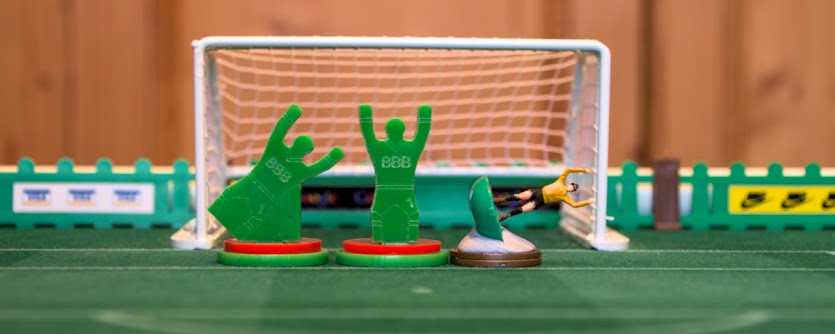I've
been in conversation with a fellow solo player David Forsyth, who to
be fair has been playing solo a lot longer than myself. He has
informed me his own solo league is now coming into it's 13th season,
and during that time he has played with all manner of player types,
but has had and still has a great affinity to the original flats.
David a retired Teacher has been one of the factors which encouraged
me to start this blog. I was delighted when he offered to write an
article with an insight to playing solo with flats. So I'll now hand
you over to David.
Solo Games with Flats
When
I was given my first Subbuteo set in 1964, the new "Continental" style
players and sets were all the rage. I don’t think it was possible
to go into any local toy or games shop and find any sets with the
original flat celluloid figures for sale, or even in view. Not that
I, or anyone else, would probably have spent our pocket money on
them. In those early days, everyone had the playing figures now known
as original heavyweights. Since then, at different times, I have
become used to playing with most of the later developments of playing
figures, and must confess that I think the modern flat based sliding
players take a dimension out of the play.
Just
over three years ago, I saw an original box set of "flats" on display
at a local toy fair. The seller informed me that it wasn’t in a
very good condition, but I reckoned it was worth a tenner just to
obtain and read the enclosed leaflets and literature. Lets just say
that most of the players were not only well past their playing days,
but most needed emergency orthopaedic surgery! Nevertheless, after
the fitter players had enjoyed (hopefully) a gentle run out and brief
training session, I became an instant convert to the original "flats"
game.
So
began the next stage of the new Subbuteo adventure, trying to obtain
a small but moderate collection of these teams, enough to form a
league. This stage progressed steadily, with several teams, and a few
more box sets, obtained from Subbuteoworld, plus a few made
privately, and finally a particularly enjoyable, successful, (and
expensive!) visit to the Collectors Fair at Renishaw in Sheffiield, and the league was
well underway.
"Positional play becomes more important". Photo courtesy of David Forsyth.
The
Play
The
first thing to notice, without stating the obvious, is that the bases
are smaller, but solid, and have no added weight inside for balance.
This gives the figures a lower centre of gravity, but because of the
celluloid, lighter in weight than many modern players will be used
to. As
a consequence, the straight line flicking "comfort zone" is
shorter, as is the natural passing distance. The ‘curl’ or ‘spin’
is tighter but, once you are
familiar with how they play, they can be more precise.
These
figures also appear to be better suited to playing the ball,
especially the very light FF one. It may surprise some readers to
know that even the original 25mm ‘big ball’ is in fact lighter in
weight than the modern 22mm one that has replaced it.
The
reason for the introduction of the heavier ball is believed to be an
attempt to make it more suited
to the heavyweight figures, when they were introduced.
How
do these conditions affect a match?
I
can only answer this one from personal experience, but the limited
comfortable flicking and passing distances make for a shorter passing
game, which, in turn means more of the team getting involved.
Positional play becomes more important, and it gives more credence to
phrases like,
“Remember
that the positioning of
figures
on your side has a large bearing on the results you will achieve”
as
printed in the Advanced Subbuteo Table Soccer handbooks of the
sixties.
Personally,
I find games played with the flats more interesting and rewarding to
play. This is because the more importance given to positioning and
tactics produce more variety in the game, as there isn’t, or
shouldn’t be, a difference in flicking skills between each team,
and solo games become more interesting when the teams play a
different formation and tactical game.
Conclusion
As
I have stated, I really enjoy matches with the card or celluloid
figures which have become known as “flats”.
I
know that the good quality teams of such figures can are rare and can
prove an expensive purchase, especially if you only intend to “give
them a try”.
On
the other hand, a fan of Subbuteo will surely enjoy the experience of
playing the Peter Adolph’s original version of this game,
especially when played with the original Advanced rules, with their
allocated times for taking blocking flicks etc., rather than the
‘rather rushed’ shorter modern version of the game, which is
possibly less suited to solo play anyway.
I
can only recommend to anyone who has an opportunity, and without a
massive cost, to take
a chance, like I did. You never know, it may provide another
enjoyable, if slightly different, way to play the game.
David
Forsyth
I'd
like to thank David for his contribution. It's been many moons since I
played with flats, and as David mentioned in his post they play so much
differently from their counterparts. They may play differently, but they
are nowhere near inferior, anyone who plays Subbuteo should at least
try them and make their own decision, will you?
Keep on Flicking.
Ian




Comments
Post a Comment